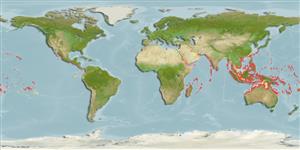Common names from other countries
Environment: milieu / climate zone / depth range / distribution range
Écologie
marin récifal; profondeur 0 - 36 m (Ref. 9710). Tropical; 30°N - 25°S
Indo-Pacific: Red Sea to the Line, Marquesan, and Ducie islands, north to the Ryukyu Islands, south to Lord Howe and Rapa islands.
Taille / Poids / Âge
Maturity: Lm ? range ? - ? cm
Max length : 22.0 cm TL mâle / non sexé; (Ref. 90102)
Épines dorsales (Total): 6; Rayons mous dorsaux (Total): 9-10; Épines anales 3; Rayons mous anaux: 36 - 45. This species is distinguished by the following characters: body depth 1.8-2.4 in SL; dorsal soft rays usually 9; pectoral rays 16-18, usually 17; gill rakers 9-7 + 19-26; caudal fin forked. Colour overall of body copper-brown, black spot at pectoral-fin base; anterior edge of first dorsal fin blackish; basal part of anal fin dusky greyish; no black margin on anal and caudal fins (Ref. 90102).
Occurs in clear, shallow lagoon and seaward reefs, quite common along the reef margin. Feeds on benthic and planktonic crustaceans, other small invertebrates, and fishes at night. By day, it forms aggregations in caves. Minimum depth reported taken from Ref. 128797.
Life cycle and mating behavior
Maturité | Reproduction | Frai | Œufs | Fécondité | Larves
Myers, R.F., 1991. Micronesian reef fishes. Second Ed. Coral Graphics, Barrigada, Guam. 298 p. (Ref. 1602)
Statut dans la liste rouge de l'IUCN (Ref. 130435)
CITES (Ref. 128078)
Not Evaluated
Menace pour l'homme
Harmless
Utilisations par l'homme
Pêcheries: intérêt commercial mineur; Aquarium: Commercial
Plus d'informations
RéférencesAquacultureProfil d'aquacultureSouchesGénétiqueElectrophoresesHéritabilitéPathologiesTraitementMass conversion
Outils
Articles particuliers
Télécharger en XML
Sources Internet
Estimates based on models
Preferred temperature (Ref.
115969): 25.5 - 29.3, mean 28.4 (based on 3053 cells).
Phylogenetic diversity index (Ref.
82804): PD
50 = 0.5000 [Uniqueness, from 0.5 = low to 2.0 = high].
Bayesian length-weight: a=0.01259 (0.00601 - 0.02639), b=3.02 (2.84 - 3.20), in cm Total Length, based on LWR estimates for this species & Genus-body shape (Ref.
93245).
Niveau trophique (Ref.
69278): 3.6 ±0.49 se; based on food items.
Résilience (Ref.
120179): Haut, temps minimum de doublement de population inférieur à 15 mois (Preliminary K or Fecundity.).
Fishing Vulnerability (Ref.
59153): Low vulnerability (12 of 100).
